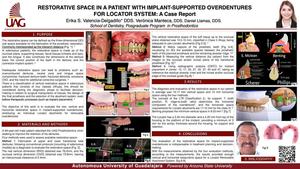
Evaluations (6/11)
Restorative Space in a Patient with Implant-Supported Overdentures: A Diagnostic Analysis for Locator System: A Case Report
by Erika S. Valencia DDS, Veronica Manteca. DDS, Daniel Llamas DDS

by Erika S. Valencia DDS, Veronica Manteca. DDS, Daniel Llamas DDS

The restorative space can be defined as the three-dimensional (3D) oral space available for the fabrication of prosthetic restoration. Inadequate restorative space can lead to problems such as over-contoured dentures, neutral zone and tongue space compromise, fractured denture teeth, fractured dentures, excessive OVD, and the need for additional corrective surgeries. Our purpose is to evaluate the restorative space from the implant platform to the occlusal plane for a patient candidate for implant-supported maxillary and mandibular overdentures with locator removable attachment system.
A 64-year-old male maxillary and mandibular edentulous patient wearing removable complete dentures attended the UAG Prosthodontics clinic seeking to improve the comfort and retention of his dentures. Four methods were used to assess available restorative space: Method 1: Fabrication of upper and lower transitional total dentures following conventional protocols (mounting of edentulous models) as a diagnostic to evaluate the restorative space. Method 2: Matrix capture of the prosthetic teeth, visualizing (in 3D) the available spaces between the prosthetic teeth of the planned prosthesis and the remaining alveolar ridge. Method 3: Measuring the vertical distance (by caliper) from the intaglio to the occlusal and/or incisal plane of the transitional prosthesis. Method 4: Using radiographic analysis (CBTC) for implant placement.
he patient demonstrates suitable horizontal and vertical restorative space for an implant-supported maxillary and mandibular overdenture with the LOCATOR removable attachment system. Evaluation of restorative spaces using multiple methods, including conventional protocols, matrix capture, caliper measurements, and radiographic analysis, provided crucial information for treatment planning decisions. Adequate restorative space is essential for avoiding complications such as over-contoured dentures, compromised tongue space, and the need for corrective surgeries.
The evaluation of the restorative spaces for implant-supported overdentures provides important information for treatment plan decision-making criteria. The patient presents horizontal and vertical restorative space suitable for an implant-supported maxillary and mandibular overdenture with LOCATOR removable attachment system.
